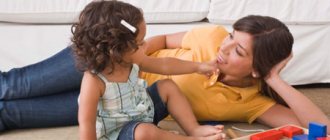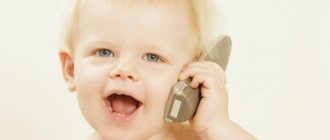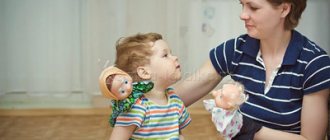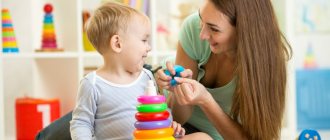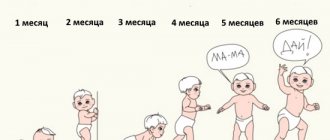Article:
A child’s speech at 2 years of age is actively formed against the background of the development of basic mental processes.
Thinking helps him compare objects with each other and establish simple connections. Increasing the stability of attention allows you to listen to stories or reading by an adult. Memory and perception are increasingly improved and make it possible to master the norms of the native language with great success. Listening to short fairy tales and short stories is already meaningful; a child can repeat after an adult complex words, simple phrases, and retell a small part on his own. In the second year of life, the baby is interested in everything that happens around him. He observes the objects of the surrounding world and masters the actions that can be performed with them. The main guides to the world of new information are adults from the immediate environment. But the baby can get help and new knowledge from them if he speaks. Communication with loved ones is the main incentive to master the native language between the ages of two and three years.
Features of speech development of children 2–3 years old
A two-year-old child has already mastered speech to such an extent that he can talk about his impressions, explain what he needs, and establish communication with peers and adults.
The normal development of a child’s speech at 2 years old leads to the fact that by the age of 2.5 years his vocabulary ranges from 1 thousand to 1200 words. This amount is 3-4 times more than the vocabulary with which he arrived at two years old. Most often he uses nouns (60% of the total vocabulary) and verbs (on average 25% of the total number of words). There are adjectives (about 10%), pronouns, prepositions, and adverbs.
Two-year-old children use participles, gerunds and numerals less often. By adjectives, child means:
- size of objects (large, small);
- color (green, red, blue, yellow, white, black);
- properties of objects (sweet, sour, cold, hot);
- qualities (good, bad);
- shape (round, square, triangular).
Generalizing words, such as toys, fruits, vegetables, clothes, furniture, dishes, animals, actively appear in the baby’s speech. He can also confuse objects from the same group, calling shoes and boots, and slippers, and even short boots, or the very concepts of vegetables and fruits. Lighter words (bi-bi instead of the word car) are becoming less and less common in a child’s speech.
Word creativity is actively developing, the baby comes up with words himself. Proof that at this age children are able to understand the sound side of a word can be seen in the textbook example given by Korney Chukovsky in his book “From Two to Five”: mazelin - Vaseline, mocress - compress.
Grammatical features of speech
The main content of children's speech at this age is simple narrative or exclamatory sentences. Complex sentences appear infrequently; their examples should be given in their speech by the baby’s parents. For example, “we won’t go for a walk today because it’s raining,” or “now we’ll read a book and then we’ll sleep.” Words in sentences in children of the third year of life are consistent in gender and number, but errors in case endings are often encountered.
Interrogative sentences are still asked by intonation, although children at this age are already able to use question words: where, why, when, how. You can suggest to your child: “Ask grandma where the car is?”, “Ask dad why the tea is hot?”, thereby giving examples of interrogative sentences.
Sound pronunciation
In the third year of a child’s life, the organs of pronunciation have become significantly stronger, the muscles of the tongue, lips, and lower jaw work more harmoniously. However, in the sound pronunciation of two-year-olds there are often many difficulties encountered, although the kids try to bring it as close as possible to the speech that sounds around them.
Most often, the pronunciation of hissing sounds suffers, which are replaced by whistling sounds, as they are easier in articulation (kasya - porridge, syapka - hat, koska - cat). Hard sounds can be replaced by soft ones (lapa - lyapa, dai - dyai), when consonants coincide, one of them is not pronounced, falls out, especially if these are sounds such as sh, zh, shch, ts, ch, l, r (stay - that , grass - tavka).
The child shortens words of 3-4 syllables, swaps syllables, and skips individual sounds, although in simple words he pronounces the same sounds flawlessly. The differences between the sound pronunciation of children of the same age by this period can be very significant. By the age of 3, some children master all the sounds of their native language, even the difficult-to-articulate sound p, while others have unclear speech with the absence of most sounds or no speech at all.
How to teach a child to speak at 2 years old?
22.11.2019
Speaking skills are important for a fulfilling life. It is not uncommon to see two-year-old children on the playground speaking clearly and clearly. But among them there are also those who express emotions by gesturing with their hands or in the form of onomatopoeia.
Many parents are starting to worry about this problem. The situation is aggravated by instructions and examples from the lives of strangers that lack of speech can lead to severe mental problems. As a result, new mothers begin to take their offspring to doctors , or, even worse, to local healers.
Diagnostics of ZRR
Every year, kindergartens send hundreds of two-year-old children to special medical and psychological commissions, where specialists individually assess the child’s speech . If any abnormalities are detected, the child is diagnosed with SRD ( speech development delay ), and parents are given appropriate recommendations. Most often, such children are sent to specialized preschool educational institutions with a speech therapy focus.
Norms of speech development
Despite the fact that a two-year-old child may not speak, he can perfectly understand speech and requests addressed to him, which indicates his full mental development. At the same time, the baby, as a rule, has a good appetite and sleep, he has basic household skills and can fulfill small requests. A deviation from the norm is the absence of phrasal speech by the age of three or four years. The reason for this can be both neurological diseases, for example PCPNS, and mental ones (stress, fear). In this case, in addition to corrective work, the child will need medication treatment.
How to teach a child to talk?
If doctors have not identified any serious problems in the child, parents, first of all, need to reconsider their behavior towards the child. Perhaps the silence of a son or daughter is due to a lack of parental attention and contact. The baby will start talking faster when he hears spoken language , so it is advisable to have the TV on or the radio on in the house.
The development of fine motor skills also contributes to the formation of speech and thinking. At one year of age, a child, under adult supervision, needs to manipulate small objects, for example, rolling beads or sorting them by color. Speech therapists two-year-old children to read poems, fairy tales, nursery rhymes, show cards with images of objects, animals and name them, do articulatory gymnastics, thus developing speech muscles.
Published in Defectology Premium Clinic
Norm of speech development from 2 to 3 years
A child of this age, with whom his parents actively communicated and studied from the first months of life, can freely navigate his surroundings, knows the names of many objects and actions performed with them. The baby listens with interest to short fairy tales with a simple plot. He cannot yet retell them in full, but he is able to repeat individual phrases or words after an adult.
By the end of the third year of life, the baby is able to memorize short texts, complete rhymes that his parents read to him many times, and guess simple riddles with clues in the text. “Long tail, small legs, afraid of cats, squeaks “pee-pee-pee.” Who is this?" Although children's speech lacks a large number of correctly pronounced sounds, the baby's statements can be easily understood.
The level of speech development in children from 2 to 3 years old depends on the situation in which the child is located. Abstract categories denoted by words like friendship, illness, fear are inaccessible to his understanding. Grammatical errors in agreeing parts of speech are considered normal at this age. The phrases spoken by the baby are most often simple, although by the end of the third year additions and circumstances may appear in them: “The girl is riding a sled,” “The dog is running fast.”
The child asks questions, reproduces the intonation of adults’ speech, both as shown and independently. The child's voice is not yet strong, the baby is not able to control it fully. So, he cannot pronounce words louder if he is asked to do so, and whispering speech is also inaccessible to him.
Speech development classes for 2-3 years old
In the “Grow Up” , our teacher Elena Salnikova works with children aged 2 years and older. She combines useful and fun exercises and games to develop motor skills, articulation, memory, attention and imagination in an hour-long lesson.
At each lesson, children perform articulation and breathing exercises and practice logorhythmics. The development of fine motor skills of the fingers has a positive effect on the development of children's speech, so we pay special attention to finger gymnastics.
Already at 2-3 years old, a child can be introduced to the study of letters, so each lesson includes a section “Getting to know the letter”: children study one of the letters visually and auditorily, sculpt it from plasticine or draw it.
In classes on speech development, children 2-3 years old learn to respond to calls, answer questions and build dialogues with each other. All exercises are done in a playful way and are based on children’s favorite images from fairy tales and cartoons.
As part of play activities for speech development, children 2-3 years old discuss pictures with their favorite characters, stage various situations with their participation, and act out scenes with lines and dialogues.
The lesson on speech development in the “Grow Up” is built on the principle of frequent changes of activities. This way, the child does not have time to get bored with this or that exercise, and he remains captivated throughout the entire process. This principle is also aimed at developing memory and attention in a child. We teach children to concentrate, remember new information and concentrate on one thing. First for a few minutes, and then more.
Signs of speech delay
After two years, some children cannot use speech as a means of communication due to the fact that children’s speech development is delayed. The cause of concern for their parents is the complete absence of speech or a limited number of available words. In addition to a poor vocabulary, speech development delay (SDD) is expressed by the following symptoms:
- the child cannot translate his thought into a speech message, he finds it difficult to answer an adult’s questions;
- active and passive vocabulary accumulate at a very slow pace;
- children have difficulty constructing even a short phrase: “The girl’s ball fell or the girl’s ball” (The girl’s ball fell);
- Children cannot not only build a common sentence on their own, but also repeat it after an adult, for example, Teddy bear came out of the forest;
- in spoken words there are often rearrangements of syllables and sounds, substitution of one sound for another;
- when pronouncing individual sounds, the child notices tension or twitching of the facial muscles;
- he does not understand the meaning of a fairy tale or nursery rhyme read by an adult, and finds it difficult to answer a simple question about its content or try to retell it;
- The baby has difficulty assembling nesting dolls, cubes, and cut-out pictures consisting of four parts.
What mistakes can parents make when developing their child’s speech?
Often the child is overly patronized and protected, they try to predict his desires - of course, out of love for him.
But then the baby does not develop the desire to work independently, he does not learn to express his thoughts through speech, and many processes in his development may be inhibited. • Intuition and love help loved ones understand a child literally at a glance. But communicating with unfamiliar people in unusual conditions will be difficult for him, and in the worst case, acutely uncomfortable. To prevent this from happening, as you grow older, you need to enter into conversations more often with new and new interlocutors, and then the child will simply be forced to improve his speech understanding skills.
• Some parents underestimate, while others overestimate, the requirements for the baby’s speech. In the first case, they do not demand anything from the child, all his wishes are guessed and immediately fulfilled, in the second, they constantly pester him: “Tell me!”, “Repeat!”. Sometimes in one family two extreme approaches are used at once: for example, dad demands, and grandmother takes care. This has a very adverse effect on the child’s speech development.
• Try to eliminate lisping, “baby talk,” and constant onomatopoeia when communicating with your baby. The parent's speech is a model for the child.
• Parents can speak very quickly or, conversely, too slowly, without pauses and different intonations, monotonously. It is important to use all the richness and diversity of language when developing a child’s speech.
• Do not try to speed up the baby's natural speech development. Avoid overwork from speech classes and memorization of poetry.
Self-diagnosis of delay
It is better to plan diagnostic measures closer to the end of the third year of life. First, you need to carefully observe the child when he plays, in ordinary situations, when communicating with peers and adults. Attention is paid to the child’s vocabulary, ability to construct a phrase, and the number of words in sentences. It is important to note whether the child speaks quickly or slowly, since a fast rate of speech is a prerequisite for stuttering.
To check sound pronunciation, children are asked to name the objects shown in the pictures, rather than repeat the words after an adult. Otherwise, it will give a biased picture, since the child, imitating his elders, pronounces sounds better than usual. The presence of the following sounds is checked:
- whistling - s, z, c;
- hissing – w, w, h, shch;
- voiced – c, b, d, d;
- sonorous - l, r.
At the same time, they determine whether the baby rearranges syllables, misses sounds in words, or shortens the words themselves. To find out how a child constructs a phrase, he is offered pictures with the actions of familiar characters depicted on them: children, pets. You can use illustrations in children's books for these purposes. It is enough that the phrases composed by the child contain 2-3 words.

